This article appeared in the Octocer 2002 issue of Stereophile Guide to Home Theater

RBH Sound has been around for 25 years, but don't think you're out of the loop if you haven't heard of the Layton, Utah company. My introduction came only a few years ago, and I've been in the loop a long time. RBH built speakers for other brands for many years, but began concentrating on establishing its own brand name about six years ago, when the home-theater boom began. Today their products are sold through 400 dealers and custom installers. After spending a few months with one of RBH's top-performing, most expensive systems, I can tell you that finding one of these dealers will be well worth your while. The RBH system I reviewed—two floorstandingRBH 1266-SEs, a 661-SE centerchannel, two 66-SE bipole surrounds, and a 1010-SEP powered subwoofer—retails for around $8046, finished in your choice of more than 30 natural veneers. In black, it'll set you back $6426. If you have a chance to see, touch, and hear this assemblage, you'll wonder, as I do, how they manage to sell it for so little.
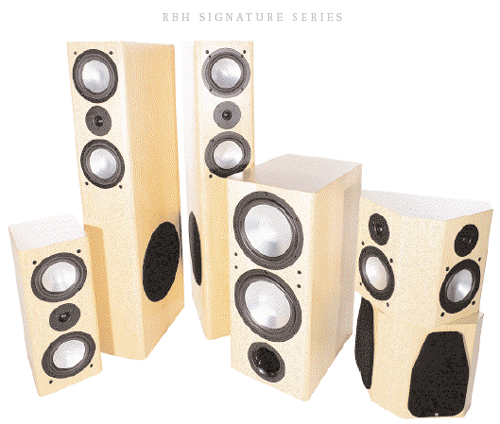
The Aluminum Connection
Save for the subwoofer, all speakers in the
system under review use variously configured pairs of identical 6
1/2-inch aluminum midwoofers (built in-house) and 1-inch silk-dome
tweeters from Vifa (each bipole/dipole surround uses two of these).
Side-mounted 12-inch aluminum-cone woofers complete each 79-lb 1266-SE
tower, while the powered 1010-SEP subwoofer sports two 10-inch,
front-mounted aluminum cones. Lightweight and stiff, an aluminum cone
can respond quickly and operate pistonically up to or near its
conveniently high resonant frequency, well above the speaker's passband.
However, once the resonant frequency is reached, the driver can ring,
if not like a bell, then at least like an aluminum funnel, creating
problems in both the frequency and time domains, so the first breakup
mode must be effectively suppressed or the material's advantages will be
lost. RBH uses a steep crossover design and a combination of thin,
lightweight epoxy damping applied to the cone's rear side, a special
surround material, and an inverted dustcap to help ensure that the
driver's breakup mode is well out of the audible range. But the cone
material is hardly the sole determinant of a driver's performance. RBH
also uses voice-coil formers of high-temperature-tolerant,
aerospace-derived Kapton, long coil assemblies for increased throw
length, and rigid, die-cast speaker baskets.
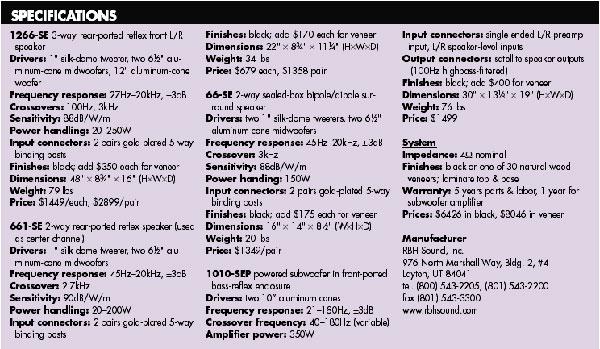
No-Nonsense Styling, Superb Build Quality
You can order the Signatures in any one of 30 high-quality natural veneers. Their appearance isn't likely to wow you, but their fit'n'finish is superb. For me, there was no denying the raw power and feeling of precision and authority exuded by those aluminum drivers with their dished, shallow metal cones and protruding, gleaming black surrounds.
While the two 1266-SEs dominated the system, the
other speakers are hardly afterthoughts. RBH's 661-SE, used here as a
centerchannel, can also be used (positioned vertically) as a left/right
speaker in a less expensive system. Its reflex port can be used open or
closed; a plug is provided for the latter option. I used it closed. The
1010-SEP, 350W powered subwoofer, with its front-mounted, double-driver
stack and port, is almost a tower itself. And the angular 66-SEs are
similar in design and function to most dipole surrounds, with their
woofers wired in phase and tweeters out of phase. This provides a
spacious overall presentation combined with good bass response. RBH
refers to them as bipole/dipole designs because of the in-phase woofers,
but they operate in one mode of operation only and do not offer an
option of two different modes, as their bipole/dipole designation might
suggest. Solid, heavy, wellbraced, precision cabinets of MDF,
high-quality veneer veneers, biwirable gold-plated terminals, stylish
feet, and well made grilles add to the appeal of the Signature package.
RBH is clearly trying to give excellent value for money. $2899 for a
pair of 4-foot-tall, 4-driver, 3-way, fullrange, 79-lb speakers? In some
parts of the specialty audio world, that's the tariff on tiny 2-way
bookshelf designs. Heavy Lifting, Easy Setup.
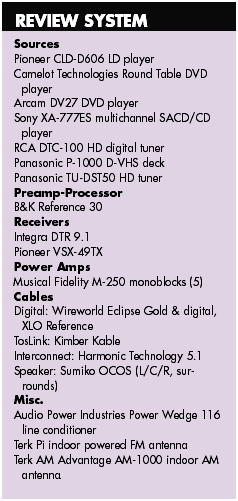
While a pair of 1266-SEs—or any other fullrange speaker—deserve careful placement for optimal sound, in the usual home-theater environment they must sit dutifully on either side of a big-screen monitor or behind a drop-down screen, and wherever those might have been placed usually has little to do with room acoustics. My home theater is no exception—it's not a "dedicated" anything except a living room. Fortunately, it works well with even full-range speakers, though they must be placed dangerously close to the rear wall—an invitation to uneven bass response. The subwoofer sat in its usual space, to the left of the left speaker, the center atop my Philips 55PP9701 55-inch, HD-ready monitor, carefully angled down toward the listening position. The surrounds were on stands to the left and right of my couch.
I ran the 1266-SEs with my A/V receivers/surround processors set for both Large and Small L/Rs to see how they performed both full-range and above 80Hz, and to hear the 1010-SEP sub's performance in both sat/sub and LFE-only modes. To perform the same test when listening to multichannel and 2-channel
SACDs through Sony's XA-777ES SACD player, I used the Sony's own bass management and the analog pass-throughs of the two receivers I used for the review. Dialing in the subwoofer to get a smooth blend proved very easy. In fact, optimizing the RBH system's overall performance proved surprisingly troublefree, despite the low-frequency heft of the 1266-SEs. Fasten Your Seat Belts! From the first overwhelming, expansive, room-shaking flourish of the multichannel The Film Music of Jerry Goldsmith (Telarc SACD-60433), it was clear that the RBH system's presentation was SUV-like: big, powerful, physical, and confident. How can a speaker sound "confident"? I don't know, but I know it when I hear it. A confident speaker doesn't flinch when asked to play loudly, or get defensive and lose its sonic equilibrium when required to speak softly. Even when they were pushed really hard, I never heard the RBH's aluminum drivers compressing the sound. Nor, when asked to be subtle and softspoken, did they (as some big speakers do) seem to shrink and fold inward, losing all tonal and rhythmic clarity. Clarity and detail poured forth at volumes extreme and everywhere in between, yet there was never unnatural etch, edginess, or harshness—unless it was in the recording.
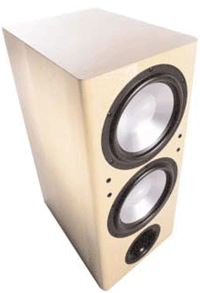 Despite
the 1266-SEs' impressive bass extension, the overall presentation—at
any volume—was never sluggish, thick, or lumpy. This was a system that
didn't confuse bass for its own sake with genuine low-frequency
extension integrated seamlessly into the sonic picture. Nor did it
confuse highs with air, transient speed, and transparency. In other
words, the overall presentation was mostly seamless and transparent.
It's rare to get this level of performance and frequency extension at
this price. Not every physically large loudspeaker produces a big sound.
I've heard some imposing-looking ones that hung what sounded like
little light bulbs of sound 3 or 4 feet off the ground around the
midrange and tweeter array, and those little pods of sound never moved
beyond the physical confines of the cabinets. In the case of the RBHs,
the system's physical size was matched by an enormous, CinemaScopic
audio picture seemingly unassociated with the three maple-veneered boxes
standing guard aside and atop my television. With the right source
material, the image produced seemed to extend from floor to ceiling and
well to the sides of the L/R speakers. Having had so many speakers in
the same location, I was simply amazed by the size, physicality, and
dimensionality of the picture produced by the RBHs. I'm used to this
kind of performance in my 2-channel room, but getting it usually
requires painstaking speaker placement, with precise toe-in or toe-out,
and certainly doesn't include having a refrigerator- sized TV screen in
between. But I simply plopped down the RBHs where they had to go, and
there it was.
Despite
the 1266-SEs' impressive bass extension, the overall presentation—at
any volume—was never sluggish, thick, or lumpy. This was a system that
didn't confuse bass for its own sake with genuine low-frequency
extension integrated seamlessly into the sonic picture. Nor did it
confuse highs with air, transient speed, and transparency. In other
words, the overall presentation was mostly seamless and transparent.
It's rare to get this level of performance and frequency extension at
this price. Not every physically large loudspeaker produces a big sound.
I've heard some imposing-looking ones that hung what sounded like
little light bulbs of sound 3 or 4 feet off the ground around the
midrange and tweeter array, and those little pods of sound never moved
beyond the physical confines of the cabinets. In the case of the RBHs,
the system's physical size was matched by an enormous, CinemaScopic
audio picture seemingly unassociated with the three maple-veneered boxes
standing guard aside and atop my television. With the right source
material, the image produced seemed to extend from floor to ceiling and
well to the sides of the L/R speakers. Having had so many speakers in
the same location, I was simply amazed by the size, physicality, and
dimensionality of the picture produced by the RBHs. I'm used to this
kind of performance in my 2-channel room, but getting it usually
requires painstaking speaker placement, with precise toe-in or toe-out,
and certainly doesn't include having a refrigerator- sized TV screen in
between. But I simply plopped down the RBHs where they had to go, and
there it was.
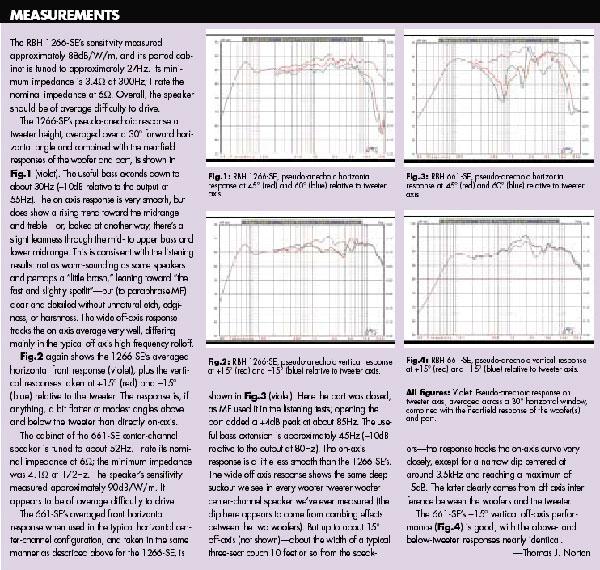 The
Aerial Acoustics system I reviewed in our May 2000 issue (anchored by
Aerial 7Bs in the left and right channels and a CC3 in the center)
produced a sonic picture of similar size, with an equally attractive but
somewhat different tonal balance. The Aerial system had been more
self-effacing, falling on the tonal and rhythmic side of warm and rich;
the RBH was more brash, leaning toward the fast and slightly spotlit.
And if, overall, the $20,000 Aerial package gets the nod for nuance and
tonal lushness of the midband, consider the difference in price, and
that many listeners—especially those into rock and pop—might prefer the
RBH's leaner, faster sound. I sat through the entire Goldsmith disc,
savoring the RBH system's tonal sophistication, particularly the adept
timbral delineation of the veneerwinds and brass, as well as the
enormity and cohesion of the surround-sound presentation.
The
Aerial Acoustics system I reviewed in our May 2000 issue (anchored by
Aerial 7Bs in the left and right channels and a CC3 in the center)
produced a sonic picture of similar size, with an equally attractive but
somewhat different tonal balance. The Aerial system had been more
self-effacing, falling on the tonal and rhythmic side of warm and rich;
the RBH was more brash, leaning toward the fast and slightly spotlit.
And if, overall, the $20,000 Aerial package gets the nod for nuance and
tonal lushness of the midband, consider the difference in price, and
that many listeners—especially those into rock and pop—might prefer the
RBH's leaner, faster sound. I sat through the entire Goldsmith disc,
savoring the RBH system's tonal sophistication, particularly the adept
timbral delineation of the veneerwinds and brass, as well as the
enormity and cohesion of the surround-sound presentation.
Like the Aerial surrounds, RBH's large dipole/bipole arrays were hardly afterthoughts. Without overwhelming the front soundfield, they filled the rear and sides of my listening room with an impressive expanse of sound without localizing their positions. Good thing, given the size and weight of the front presentation. The DTS/DVD-Audio 5.1-channel remix of Queen's A Night at the Opera restated the RBH system's musical prowess, especially in terms of rhythmic and dynamic authority. Not the greatest recording to begin with, the remix tastefully spreads the material around without doing damage to the original mix's coherence and timbral balance.
The vocals had plenty of bite, but without harshness or edginess. It was fun re-experiencing this album in 5.1—especially through a system that could do it justice. Still, rock recordings are basically collections of panpotted mono signals spread across an artificial reverb field; I'd rather hear them in 2-channel, or—dare I say it? yes, I do—in mono!
One of the music tracks that had mesmerized and surprised me through the Aerial system was Suzanne Vega's "Caramel," from Columbia/Legacy's 5.1-channel Dolby Digital DVD, The Best of Sessions at West 54th. In the Aerial review, I wrote: "I'd never heard the bass line on 'Caramel' exhibit such physical presence, tonal purity, detail, rhythmic tautness, and extension. Nor had I heard Vega's voice sound as liquid and smooth, yet articulate. The same for her guitar, which possessed both transient string attack and resonant body. The accompanying cello, accordion, and clarinet were rich and full-bodied but never leaden. Very familiar music sounded startlingly more exciting and believable than I'd ever heard it before." The Aerial system was a revelation.
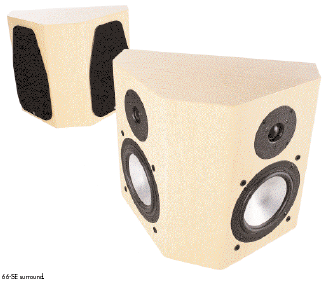 While
the RBH system was not quite up to reproducing "Caramel" with the same
overall authority and believability, and while this level of
home-theater performance is no longer a revelation, the Signatures came
very, very close to what I remember from the Aerials, especially with
that bass line. The 1010-SEP subwoofer was no match for the Aerial
SW12's low-end extension and flexibility (parametric bass EQ and a host
of other sound-tailoring features). But overall, and in conjunction with
the 1266-SEs, the 1010-SEP had the same taut, detailed, tonally pure
delivery, without lumpiness or onenote bass, and for a whole lot less
money. I bought an SW12, so, unlike the rest of the Aerial system, it
was still on hand for a direct comparison. No, the 1010-SEP was not the
equal of the SW12, but the RBH came closer to the Aerial's performance
than any other subwoofer I've had here since—especially when reproducing
music. The Aerial does better with atomic bombs, large room ambiences,
and the like, but considering the difference in price, the 1010-SEP is
an incredible value, and one of the most accomplished subs I've heard.
You'll be hard-pressed to tax its dynamic performance in a room of
normal or even large size; more impressively, you'll have a harder time
"hearing" it as opposed to experiencing it, which is as it should be.
While
the RBH system was not quite up to reproducing "Caramel" with the same
overall authority and believability, and while this level of
home-theater performance is no longer a revelation, the Signatures came
very, very close to what I remember from the Aerials, especially with
that bass line. The 1010-SEP subwoofer was no match for the Aerial
SW12's low-end extension and flexibility (parametric bass EQ and a host
of other sound-tailoring features). But overall, and in conjunction with
the 1266-SEs, the 1010-SEP had the same taut, detailed, tonally pure
delivery, without lumpiness or onenote bass, and for a whole lot less
money. I bought an SW12, so, unlike the rest of the Aerial system, it
was still on hand for a direct comparison. No, the 1010-SEP was not the
equal of the SW12, but the RBH came closer to the Aerial's performance
than any other subwoofer I've had here since—especially when reproducing
music. The Aerial does better with atomic bombs, large room ambiences,
and the like, but considering the difference in price, the 1010-SEP is
an incredible value, and one of the most accomplished subs I've heard.
You'll be hard-pressed to tax its dynamic performance in a room of
normal or even large size; more impressively, you'll have a harder time
"hearing" it as opposed to experiencing it, which is as it should be.
While RBH Signatures resembled the Aerial system
in many ways, physically and sonically, I don't mean to suggest that
the RBH was the Aerial's equal overall. The center, surrounds, and
powered subwoofer lacked the Aerials' incredible setup flexibility, and
the Aerial sub and surrounds are remote-controlled. And the Aerial CC3
center- channel's delivery of voices is second to none, in my
experience, while the RBH was merely outstanding. Still, when you
consider the price difference and the RBH system's superb build and
sound quality, you get to play in the same ballpark for less than a
third the price. Bottom line: If you're putting together a dual-use
system, the RBH Signatures will shine in music mode. No Surprises in
Movie Mode Either As you might imagine, a system seemingly without
dynamic or low-frequency limitations, with low overall coloration, and
with an enormous soundstage, should do very well at the movies. I
watched dozens of movies in casual mode (as opposed to Nitpicky Reviewer
mode), and the RBH system's performance never disappointed. It managed
to stay out of the way and not call attention to itself while delivering
staggering dynamic contrasts when called for, explosive deep bass, an
enormous soundstage freed from the physical locations of the speakers,
and, most impressive, superb resolution of inner detail. The last was
all the more apparent when I went back to watch familiar scenes from my
demo movies. On the Tron soundtrack—the recording of which I supervised,
and so know almost every element that went into every sound effect—I
heard details I swear I haven't heard since the mixing stage. I'm sure I
would have heard them through the Aerial system, and I'm sure I'll hear
them through other top-quality systems yet to be auditioned, but when I
consider the price of the RBH system, the level of performance it
delivered was remarkable.
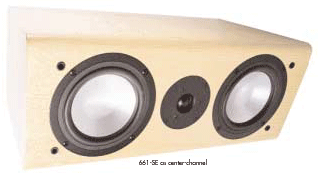
Even the woofer-tweeter-woofer centerchannel provided fine performance—including off-axis, where lobing should have resulted in compromised performance. I was hard-pressed to hear any problems—intelligibility and vocal timbres remained outstanding across a wide listening angle. I've heard more impressively neutral centers, such as the large, sophisticated, yet inexpensive one included in the Infinity package I reviewed in the January 2002 issue. The 661-SE and the 1266-SEs seemed to have a slight excess of energy in the upper midrange that was less of a problem in the other channels, but was more noticeable with dialogue. But I'm trying hard to find fault here—the truth is, I enjoyed every minute I spent with the RBH Signature system, whether listening to music or watching movies.
Conclusions
It's always more fun to review a system that performs superbly, and doubly enjoyable when it provides great value for the money. The RBH Signature system brought me nothing but pleasure. I recommend it to you without qualification. In my many years of reviewing, I can think of few systems that have provided such a high level of build quality, fit'n'finish, and performance for such a reasonable price.